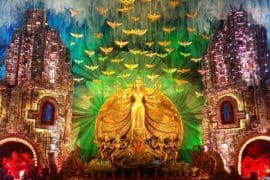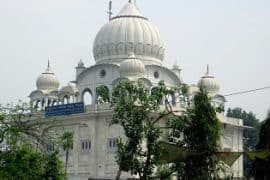Bandi Chor Diwas is a remarkable story of secularism and provides valuable insights on tolerance, love and acceptance in today’s communally volatile climate.
After the infamous Sikh-separatist Amritpal’s month long manhunt, a succeeding panic among the Sikh diaspora in Canada of Sikhs supposedly being cornered in India, frequent incidents of arson, a celebratory parade on the death anniversary of Indira Gandhi and the recent killing of Hardeep Nijjar and the resulting India-Canada row has led to resurfacing of the Khalistan issue. Even though there is little to no support for the cause in Punjab today, this secessionist demand for a separate Sikh state, Khalistan, reverberates loudly within the Sikh diaspora. Although these voices pose no imminent danger, they definitely do result in sidelining of pertinent issues raised by Punjabis back home, thereby requiring immediate remedial actions against such forces.
An ideological shift can be employed as a corrective measure and one need not go too far, actually it would require these separatist elements to go back to what Sikhi truly means. Last week was filled with Diwali festivities, Bandi Chor Diwas, one of the most important festivals for Sikhs was among them. The story behind celebrating this day is secular in the truest and most beautiful way. Bandi Chor Diwas, Prisoner Liberation Day, marks the celebration of homecoming of the sixth Sikh Guru, Guru Hargobind, when he returned from Gwalior Fort along with 52 Hindu kings.
The establishment of Akal Takht at Harimandir Sahib (Golden Temple), and the growing strength of the Sikh army under Guru Hargobind instilled the fear of a potential danger from Sikhs in the mind of Nawab of Lahore, who then relayed this anxiety to Emperor Jahangir. Jahangir, who also feared that the sixth Guru might want to avenge his father, Guru Arjan’s death, demanded an immediate arrest of Guru Hargobind. He was taken to Gwalior fort, where he met several imprisoned Rajput kings. A sufi saint, Mian Mir, an admirer of the Guru, asked the emperor to release him. Upon this persuasion, Guru’s release was ordered, but the offer was refused by Guru who demanded that the Rajput kings shall also leave along with him. Jahangir, although initially reluctant, finally gave in when coaxed by Wazir Khan and agreed on releasing as many kings who could leave the fort while holding onto the Guru’s cloak. Legend has it that the Guru outwitted the Emperor by getting a special Chola with 52 panels attached to it. That day 52 Rajput kings left the Gwalior fort along with the Guru. Guru arrived at Amritsar on Diwali and people welcomed him, rejoiced his return by lighting diyas. To this day the tradition continues and Sikhs continue to celebrate Bandi Chor Diwas by lighting diyas and lamps.
On one occasion Guru was queried by Jahangir to adjudge the better religion of the two, Hinduism or Islam. In response to this,Guru quoted Kabir, “Hindhoo Thurak Dhuhoon Mehi EaekaiKehai Kabeer Pukaaree”, one lord resides within both Hindus and Muslims. All the 10 Sikh Gururs have at all times propounded secularism and protection of the oppressed from the oppressor. “Manas ki Jaat sab eke pehchanbo”, recognising the entire human race as one, was the foundational idea behind the establishment of Langar Seva by Guru Nanak. A secular state in it’s truest sense was conceived under Maharaja Ranjit Singh, 80 years after the demise of the 10th Guru. Khushwant Singh writes that the biggest contributing factor to Ranjit Singh’s success ‘was his respect for all faiths’. His court hosted ministers from all faiths and reflected the secular pattern of his religious policy. In conversation with a Muslim saint, he once said, “God wanted me to look upon all religions with one eye; that is why he took away the light from other”.
What is utterly baffling is that the Khalistani elements, pose themselves as the representatives of the entire Sikh community and advocate for a separation that any Sikh Guru would consider preposterous. Albeit the movement took birth in Punjab, today it echoes loud on the opposite side of the globe, causing damage to the image of Punjabis back home. The patriotism of the Sikh Kaum can never be questioned – be it the martyrdom of Gurus to protect persecuted faiths, the valour exhibited by Ranjit Singh against the Britishers, contribution of revolutionaries like Bhagat Singh during the independence struggle, the unparalleled bravery of Sikh regiments during wars India has fought; they have stood true to what a “Singh” symbolizes, a lion. Today, relevant issues like agrarian crisis, unemployment, drug abuse are put on the back burner when narratives of “Sikh Secessionism” dominate the mainstream media and politics. These miniscule proponents of a separate Sikh state and their hyper sensationalism by media houses are causing an irreversible damage to the integrity and welfare of Punjabis back home, thus urgently requiring them to internalize takeaways from Sikhism’s Secularism.
Photo Credits: Siasat.com
Rubani Sandhu










